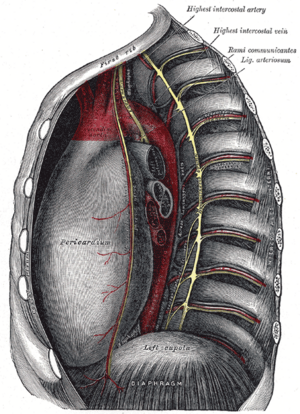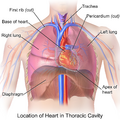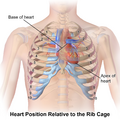Thoracic cavity facts for kids
Quick facts for kids Thoracic cavity |
|
|---|---|
| Latin | cavitas thoracis, cavum thoracis |

The thoracic cavity is also called the chest cavity. It is a special space inside your body, found in animals with backbones. Your rib cage and the muscles, skin, and other tissues around it protect this important area. Right in the middle of your chest cavity is a central part called the mediastinum.
Your chest cavity has two main openings. The top opening is called the thoracic inlet. The bottom opening is much larger and is known as the thoracic outlet.
Contents
What's Inside Your Chest?
The thoracic cavity holds many vital organs and structures that help your body work. Here are some of them:
- Heart and Blood Vessels: This includes your heart and the big blood vessels connected to it. These are like major highways for blood, carrying it to and from your heart and lungs. Examples are the main aorta (which sends blood to your body), the pulmonary artery (which sends blood to your lungs), and the large veins like the superior vena cava and inferior vena cava (which bring blood back to your heart).
- Breathing System: This includes your diaphragm (a muscle that helps you breathe), your windpipe (trachea), the tubes that branch off it (bronchi), and your lungs. These all work together to help you breathe in oxygen and breathe out carbon dioxide.
- Digestive System: Part of your esophagus, the tube that carries food from your mouth to your stomach, passes through your chest cavity.
- Glands: The thymus gland is located here. It's important for your immune system, especially when you are younger.
- Nerves: Important nerves like the vagus nerve and sympathetic chains are found here. They help control many body functions, including your heart rate and digestion.
- Lymphatic System: The thoracic duct, a large tube that carries lymph (a fluid that helps fight infections), is also in your chest.
Important Spaces in Your Chest
Inside the thoracic cavity, there are three main spaces, each lined with a special smooth tissue:
- Pleural Cavities: You have two of these, one around each lung. They help your lungs move smoothly when you breathe.
- Pericardial Cavity: This space surrounds your heart. It helps protect the heart and allows it to beat without friction.
The mediastinum is the central area between your lungs. It contains your heart, major blood vessels, windpipe, esophagus, and thymus gland.
When Things Go Wrong
Sometimes, the pleural cavity (the space around your lungs) can be damaged. For example, if someone gets a wound from a bullet or a knife, air can get into this space. When air gets in, it's called a pneumothorax. If too much air gets in, one or both of your lungs might collapse. This is a serious condition that needs immediate medical help from doctors.
Images for kids
See also
 In Spanish: Tórax para niños
In Spanish: Tórax para niños



